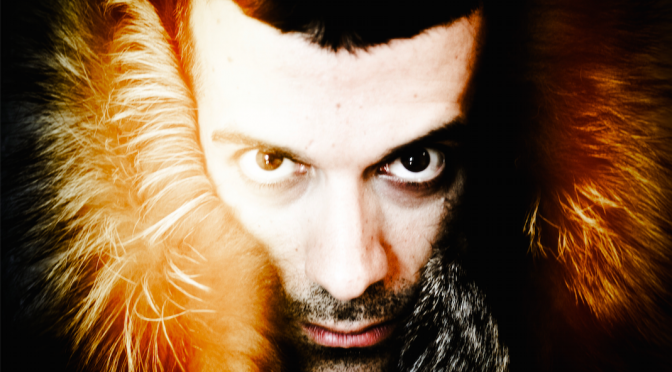By Ioli Andreadi, theatre director and Visiting Research Fellow
A group of Italian journalists enter the rehearsal room, interrupting the rehearsal in order to have a look at the space. The three actors – Miltiadis Fiorentzis, Eleana Kafkala and Maria Proistaki – the set designer, Dimitra Liakoura, and I stop because the reading of the play requires quiet and solitude. One of the journalists asks us what play we are working on and we reply. He says: “Ah! The Cenci family is Italian and I happen to know the family’s last descendant. Franco Cenci is my friend. He is an artist whose work is inspired by his family.” I ask him whether he could introduce me to him. I write down my e-mail address on a piece of paper, using big letters, to make sure there’s no misunderstanding. He promises to introduce us. The group leaves. The rehearsal continues.
It is July 2015 and I am in rehearsals at the Michael Cacoyannis Foundation, in Athens, Greece. The Cenci Family is a new play, co-authored by Aris Asproulis and me, inspired by The Cenci by Antonin Artaud and The Cenci by Stendhal, as well as by poems by Arthur Rimbaud, Albert Camus and Allen Ginsberg.
The Cenci Family is a theatrical proposition that is dramaturgically based on the play The Cenci by Antonin Artaud and on the homonymous chronicle by Stendhal. The narrated parts draw their inspiration from Stendhal’s text and the basic structure of Acts and Scenes is based on Artaud, together with some of the characters’ names. In this new play the heroes of Artaud’s play are compressed into three characters and their basic qualities are altered. Both the relationships developed between the characters and the actions that take place follow a free theatrical reimagining of the old story. A new language was invented, in form and in content, which, drawing elements from Artaud, Stendhal, Rimbaud, Camus and Ginsberg, attempts to present a 16th century story today, in a mediated and spatially confined way: as if the heroes knew in advance the fate that awaits them and mocked themselves about it, trapped inside an imaginary show frame that provides them with prestige but does not allow for any exit, theatrical or real.
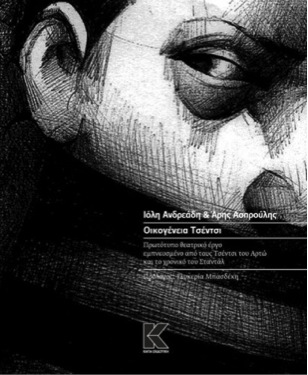
In a few days an e-mail is forwarded to me by Stella Angeletou, the Michael Cacoyannis Foundation’s Director of Programming:
Dear Stella,
My friend Andrea told me about your project related to Beatrice Cenci.
I would be very happy to contribute to your staging the piece and I would also be elated if the exhibition I made in 2013 in Rome could be set up in Athens for the occasion. I am sending you attached the PDF of the catalogue of the exhibition I made upon Beatrice Cenci in a Roman art gallery in 2013. It includes the critical presentation written by art critic Manuela De Leonardis in Italian. In a few days I shall e-mail you the English translation of her text, together with a few more photographs of other works of mine.
The 2013 exhibition included three series of works. A first one consisted in photographs of the places presumably crossed by Beatrice while moving from her Roman mansion to the small village where she would be detained. A second series consisted in photographs related to the acts of violence underwent by Beatrice. A third series was composed by 10 ceramic tiles inspired by the most significant episodes in Beatrice’s life. They were made by a master ceramist after my drawings.
I hope the whole initiative about the Cenci family will be successful. I’ll write you again in a few days.
My best greetings,
Franco Cenci
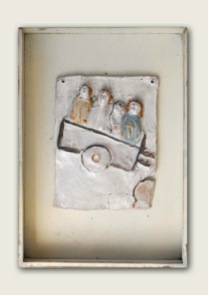
I am reading the above e-mail, written by the Cenci family’s last descendant. I let the three actors know about it and they use it as part of their research. Miltiadis Fiorentzis, who played the part of Count Francesco Cenci, said to me: “this information fortified my sense that what we are working on touches upon the present, while providing me with a metaphysical connection between now and the sixteenth century”.
A correspondence starts between Franco and me, yet it is not possible to co-ordinate a visit of Franco Cenci in Athens that would coincide with the show. A few months go by. The Cenci Family premiers on the 16th of October. It is a big success. It receives excellent reviews by numerous theatre critics. A few days before Christmas, I am travelling to Rome. I send an e-mail to Franco Cenci and he agrees to meet.
We meet near the Quartiere Cenci, the area in Rome that, during the sixteenth century, belonged to the Cenci family. Via Beatrice Cenci, a street named after Beatrice, Count Francesco Cenci’s daughter, leads to Piazza Cenci, a square named after the family. Inside the square there is Palazzo Cenci, the palace which the family used to inhabit and that now is a residential building, closed to the public.
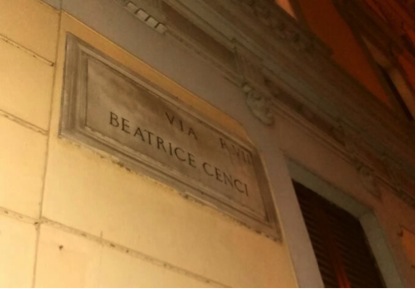
We find a quiet café at the Jewish Ghetto district and we sit around a table. Drinks are ordered. Manuela de Leonardis, the art critic mentioned in Franco’s initial letter, is there too. He talks about how his work is inspired by the Cenci family and how he was particularly moved by Beatrice, the Count’s daughter, to the point that he asked his own daughter to pose as Beatrice Cenci for a series of photographs. He shows us the photographs depicting his daughter – impersonating Count Cenci’s daughter – during her days of imprisonment and torture, right before her death in front of the eyes of the Roman public. Pope Clemens VIII’s, the same Pope who had ordered Giordano Bruno’s execution, had decided to punish her for killing her father who had tortured and raped her. Franco’s daughter reminds me of Maria Proistaki, the young actress who plays Beatrice in the show I’ve directed in Athens. I show Franco and Manuela a series of photographs taken during the performances of The Cenci Family at the Michael Cacoyannis Foundation by well-known photographer Panos Michail, who combines a strong personal interpretation of his photographed theatrical subject with a very intimate point of view, as if he could see a character from the inside out. Panos has taken the pictures of Maria Proistaki (Beatrice Cenci), Eleana Kafkala, another talented and beautiful young actress who plays four parts and represents ‘society’ in the play and Miltiadis Fiorentzis (Count Francesco Cenci).
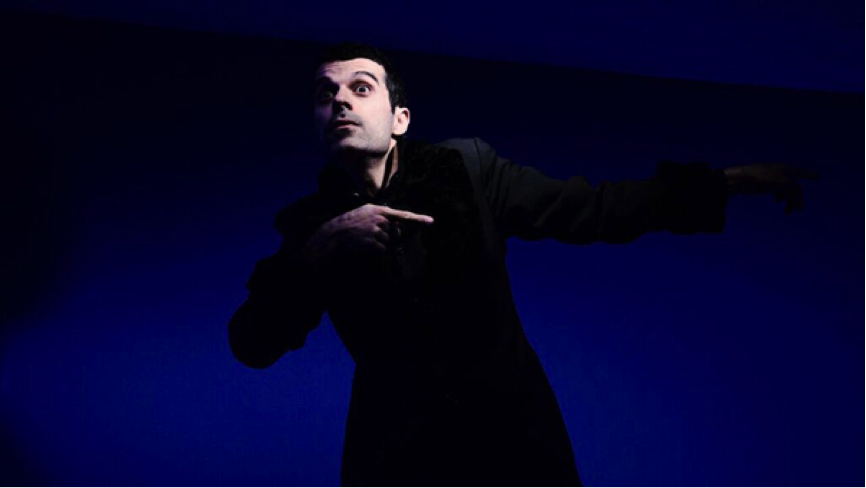
Franco Cenci then opens the large portfolio that he was carrying with him, showing Manuela and I some of his other works which were inspired by the 16th century story of his family: a series of drawings showing the main areas that the Cenci Family visited during their dark story of incest and punishment, ranging from the Palazzo Cenci to the Castle in Petrella, as well as a series of reproductions of 16th century official documents with the family’s seal on them.
I tell Franco that I am touched I was able to meet the family’s last descendant. He looks at Manuela, smiles apologetically and says…
I tell Franco that I am touched I was able to meet the family’s last descendant. He looks at Manuela, smiles apologetically and says: “I am not the Cenci Family’s last descendant. But I do share the same name and I was moved by their story”.
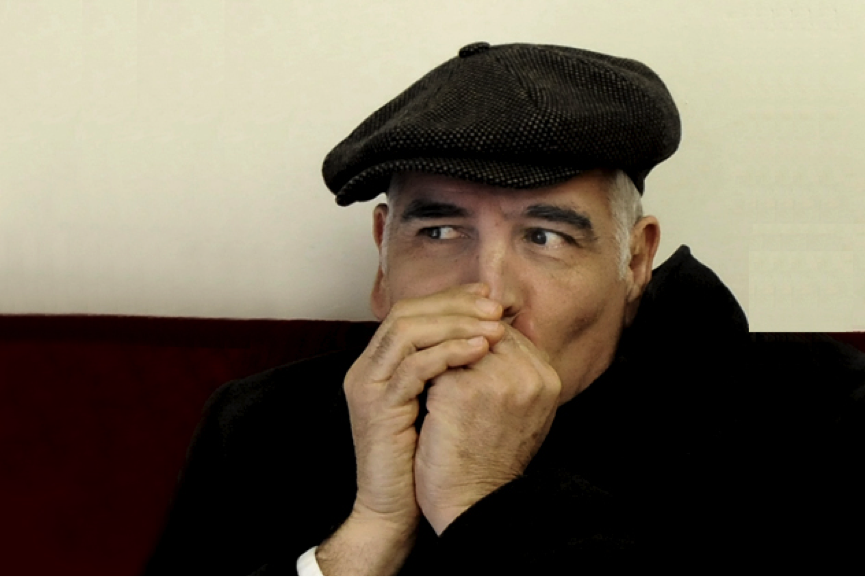
I am surprised. He continues, with Manuela’s help, who translates in English every word that does not immediately come to his mind: “A series of coincidences led me to get involved with this story. We share the same name. My own daughter, as a child, used to play with the last descendant of the Judge who had condemned Beatrice. The more I looked into the Cenci story, the more I found that things considered to be historically accurate could be challenged. For example, Beatrice Cenci was not a 16 year old child. She was a 23 year old young woman, who had not married yet. The people of Rome did not want to admit this truth. They found the idea of a much younger girl who was raped by her father and condemned to death much more moving. Furthermore, the famous painting attributed to Guido Reni and said to be depicting Beatrice, is not depicting Beatrice but Sibylla. Franco Cenci continued talking to me. He insisted upon paying before we parted.
The more I looked into the Cenci story, the more I found that things considered to be historically accurate could be challenged.
When I was writing my PhD I had examined ways of witnessing. I was fascinated by Dwight Conquergood’s notion of the co-performer witness, a hybrid between researcher and performer, sensitive to, listening and paying attention to the people he investigated, performing an anthropology of “the ears and the heart”. I was reminded of these qualities by Franco Cenci, who, in order to investigate the traces of a family and make art about it, plays the part of this family’s last descendant, producing documents, drawings, pictures that he imagines and that are as close to the historical facts as his imagination and sensitivity allow. Here are two links on Conquergood’s work that suggest the collaboration between the analytic and the artistic in research:
http://www.mitpressjournals.org/doi/abs/10.1162/105420402320980550?journalCode=dram#.VrEZYJqe3IU
http://www.csun.edu/~vcspc00g/301/perfasmoralact.pdf
What do Franco Cenci’s artworks, that are mediated – artworks are – and then mediated again – the artist who has conceived and constructed them has also, in a way, conceived and constructed himself as kin and as close to them as he possibly could – have to say about the complex function of history and memory in art and theatre?
In Alan Read’s book, Theatre in the Expanded Field: Seven Approaches to Performance, the ceramic tile – that belongs to the Ceramic era – promises interactivity with the environment through its porous surface, while at the same time preserving and protecting from it through the recalcitrance of the veneered surface. Read maintains this recalcitrance is useful when thinking about interactivity in theatre and performance. Franco Cenci’s ceramic tiles, interacting with their environment through their porous surface and resisting to this interaction through the veneered surface, seem to belong to another, older era. They don’t. They were produced with the help of the artist’s identity game and kinship-as-performance. They can perhaps serve as a reminder that bridging the gap between research and interpretation, “theory-centered” and “practice-centered” perspectives in the arts, can be based upon mutual fascination, personal involvement and playing games.
If you are interested in reading more about the integration of “practice-centered” and “theory-centered” perspectives with the help of cognitive neuroscience you can read this.
Franco Cenci said that the Cenci family’s last descendants live in a farm outside Rome. He once spoke with them on the phone. One could argue that their dark history, as well as the centuries that have gone by, seem to have deprived the rich family from its prestige and social stature. They happen to be the descendents of Bernardo Cenci, the young brother of Beatrice, the only one who was not condemned to death. Bernardo was imprisoned and deprived from his wealth. Sometime later, his fortune would be returned to him, as Stendhal writes. However, during his relatives’ execution, he had been forced to watch them die in front of the public of Rome.
I remember the very beginning of T.S. Eliot’s The Waste Land. It is an epigraph, an extract from Petronius’s Satyricon, about the immortal Sibylla:
Sibylla ti theleis; respondebat illa: apothanein thelo.
(What do you want, Sibylla? She replied: I want to die.)
The last descendent of the Cencis proved to not be the last descendent. He is an artist who chose to become a relative of the family he wanted to investigate and who, in this process, involved other members of his own family as his accomplices, such as his daughter. At the same time, the last descendent lived in a farm outside Rome, carrying or not carrying the weight of the tragic story that had once caused his family a lot of sorrow.
the last descendent lived in a farm outside Rome, carrying or not carrying the weight of the tragic story that had once caused his family a lot of sorrow.
The real 16th century story of power, incest, punishment and death of the avengers could be seen as a classical tragedy in that it is full of big events that seem to be far from our contemporary everyday lives but can reach us rapidly in the form of our worst fears and nightmares, perhaps teaching us something about history and punishment, or some part of a broader History of Punishment. One of the Eternal City’s old stories invites us to witness it, make art and write plays about it. Or, perhaps, we think that we are invited by it, for this story would most likely ask for the same thing that Sibylla wished for herself: to have her immortality annulled and simply die.
Ioli Andreadi’s work is interdisciplinary, drawing from anthropology, theatre studies, performance studies, neuroscience and theatre practice. She was awarded her PhD from KCL in 2014. There, she talks about a Northern Greek ritual in relation to the anthropological notion of witnessing and stage practice.

